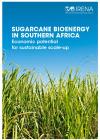

-
-
IRENA (2019), Sugarcane bioenergy in southern Africa: Economic potential for sustainable scale-up, International Renewable Energy Agency, Abu Dhabi.
Copied
/-/media/Files/IRENA/Agency/Publication/2019/Apr/IRENA_Sugarcane_bioenergy_2019.pdf
Copied
Sugarcane bioenergy in Southern Africa: Economic potential for sustainable scale-up
Newsletter
Southern African countries possess substantial sugarcane industries that could also be a significant source of sustainable heat, power and biofuels. This study reviews the bioenergy potential from sugarcane and associated development costs in seven sugar-producing countries in the Southern African Development Community (SADC), aiming to provide a foundation for more detailed country-level studies exploring practical potential.
The Southern Africa Centre for Renewable Energy and Energy Efficiency (SACREE) has specifically identified the potential for sugarcane bioenergy development in Eswatini (formerly Swaziland), Malawi, Mozambique, South Africa, Tanzania, Zambia and Zimbabwe. With support from development agencies and engagement by government policy makers, the seven sugar-producing countries could convert this high-yielding energy crop into expanded, sustainable bioenergy production.
Among the findings:
- Substantial potential exists to scale up the sustainable production of bioenergy from sugarcane cultivation in all seven countries.
- If yields were improved and all the sugarcane surplus to sugar requirements were converted to bioenergy, some 1.4 billion litres of ethanol could be produced at an average cost of USD 0.71 per litre of gasoline equivalent, all within the 554 000 hectares of land where sugarcane is already cultivated in the seven countries studied.
- Prospectively, land for sugarcane cultivation could expand as much as nine-fold, to some 5.1 million hectares (Mha) of rain-fed land without irrigation, or 99-fold to some 54.9 Mha of land if irrigation were introduced.
- Bioenergy output could expand to some 72 billion litres of ethanol, at prices largely competitive with gasoline, and 156 terawatt-hours (TWh) of electricity per annum.
- New technologies and high-energy crop varieties could further expand bioenergy production potential and reduce fuel and electricity prices.




